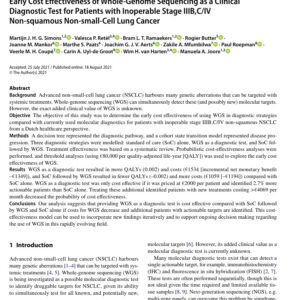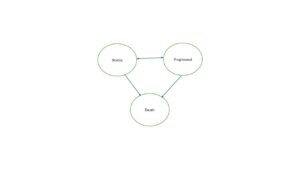Your cart is currently empty!
Cost-Effectiveness and Budget Impact Model of Future Developments With Whole-Genome Sequencing for Lung Cancer Patients
All your purchased models will be available under your account under “Dashboards”
Disease Area (Primary)
NSCLC
First Developed
08/14/2022
Last Developed
08/14/2022
Software Used
Microsoft Excel
Model Sponsor
Healthcare organization
Intervention
whole_genome_sequencing
Model Validation Score
– %
Coming Soon In Phase II: You will be able to pay a fee to download the CADTH Tool for your model which includes subaggregated scores.
Results
Total costs and quality-adjusted life-years for SoC in metastatic non-small cell lung cancer were €149 698 and 1.235. Incremental outcomes of WGS were €1529/0.002(base model), -€222/0.020(scenario 1), -€2576/0.023(scenario 2), €388/0.024(scenario 3), -€5041/0.060(combined unweighted), and -€1715/0.029(combined weighted). The annual BI for adopting WGS for this population in The Netherlands ranged between €682 million (combined unweighted) and €714 million (base model). The consequences of uncertainty amounted to €3.4 million for all scenarios (combined weighted) and to €699 000 for the diagnostic yield of WGS alone (combined weighted).
Conclusion
It is likely for WGS to become cost-effective within the near future if it identifies more patients with actionable targets and show the impact of uncertainty regarding its diagnostic yield
Source File(s)
Model Review
Only visible for the model owner
Summary
Validation Score
– %
Internal Comments
–
Full review
| 01 Model Built Reflective | yes |
|---|---|
| 02 Model Subgroups | yes |
| 03 Model Assesses all comparators | yes |
| 04 Model Incorporates costs | yes |
| 05 Model assesses all outcomes | yes |
| 06 Model structure validated by experts | yes |
|---|---|
| 07 Model aligns with or justifies deviation from previous models | yes |
| 08 Time in health states | yes |
|---|---|
| 09 Consistency with time in states | yes |
| 10 Clinical events extractable | yes |
| 11 Consistency with number of clinical events | yes |
| 12 Impact of adverse events | yes |
| 13 Consistency with adverse events | yes |
| 14 Life-years reported | yes |
| 15 Impact on mortality | yes |
| 16a Reasons for mortality differences | yes |
| 16b Reasons for mortality differences | yes |
| 16c Reasons for mortality differences | yes |
| 16d Reasons for mortality differences | yes |
| 17 Main driver of incremental life-years | yes |
| 18 Consistency with mortality rates | yes |
| 19 No technology-specific utilities used | yes |
| 20 Main driver of cost-effectiveness | yes |
| 21 Extrapolation methods identified | yes |
| 22 Adjustable time horizon | yes |
| 23 Double counting avoided | yes |
| 24 Surrogate vs final outcomes alignment | yes |
| 25 Flexibility for treatment effect waning | yes |
| 26 Access to deterministic and Monte Carlo results | yes |
|---|---|
| 27 Clear trace from inputs to outcomes | yes |
| 28 Macros used only for simulation/navigation (Excel) | yes |
| 29 QALY equivalence across technologies | yes |
|---|---|
| 30 Extreme effectiveness impact on QALY | yes |
| 31 Slight effectiveness impact on QALY | yes |
| 32 Increased mortality lowers QALYs | yes |
| 33 Reduced mortality increases QALYs | yes |
| 34 Increased baseline risk lowers QALYs | yes |
| 35 Reduced baseline risk increases QALYs | yes |
| 36 Zero mortality leads to equal life-years | yes |
| 37 Cost change affects only total costs | yes |
| 38 Utilities = 1 makes QALYs equal life-years | yes |
| 39 No discounting increases QALYs/costs | yes |
| 40 Higher discounting decreases QALYs/costs | yes |
| 41 Shorter time horizon lowers QALYs/costs | yes |
| 42 Inputs switchable across alternatives | yes |
| 43 Cost-QALY correlation across simulations | yes |
| 44 Strong cost correlation from Monte Carlo | yes |
| 45 Strong QALY correlation from Monte Carlo | yes |
| 46 Deterministic ≈ Probabilistic results | yes |
| 47 Backward trace from results to inputs | yes |
|---|---|
| 48 Backward trace from results to inputs | yes |
| 49 No use of non-transparent Excel functions | yes |
|---|---|
| 50 No hidden sheets, rows, or columns | yes |
| 51 No custom formulas inside VBA macros | yes |
| 52 Parameters persist after macros | yes |
| 53 Transparent input structure in single worksheet | yes |
| Private internal comments | – |



